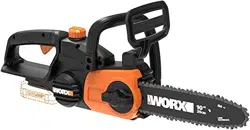Loading ...
Loading ...
Loading ...

20V cordless chain saw, 20V 2-in-1 pole saw/
chain saw (WG322 WG322.9 WG323 WG323.9)
8
EN
not store cells or batteries haphazardly in
a box or drawer where they may short-
circuit each other or be short-circuited by
conductive materials.
10)Do not subject cells or batteries to
mechanical shock.
11)Keep cells and batteries clean and dry. Wipe
the cell or battery terminals with a clean
dry cloth if they become dirty.
12)Do not maintain secondary cells and
batteries on charge when not in use.
13)Retain the original cell and battery
literature for future reference.
14)Do not use any charger other than that
specifically provided for use with the
equipment. Secondary cells and batteries
need to be charged before use. Always
use the correct charger and refer to the
manufacturer’s instructions or equipment
manual for proper charging instructions.
15) When possible, remove the battery from
the equipment when not in use.
16) Prevent unintentional starting. Ensure
the switch is in the off-position before
connecting to battery pack, picking up
or carrying the appliance. Carrying the
appliance with your finger on the switch or
energizing appliance that have the switch
on invites accidents.
17) Disconnect the battery pack from the
appliance before making any adjustments,
changing accessories, or storing appliance.
Such preventive safety measures
reduce the risk of starting the appliance
accidentally.
SAVE THESE INSTRUCTIONS
Instructions concerning the proper
techniques for basic felling, limbing, and
cross-cutting
1. Felling a tree
When bucking and felling operations are
being performed by two or more persons at
the same time, the felling operations should
be separated from the bucking operation by
a distance of at least twice the height of the
tree being felled. Trees should not be felled in
a manner that would endanger any person,
strike any utility line or cause any property
damage. If the tree does make contact with
any utility line, the company should be
notified immediately.
The chain saw operator should keep on the
uphill side of the terrain as the tree is likely to
roll or slide downhill after it is felled.
An escape path should be planned and
cleared as necessary before cuts are started.
The escape path should extend back and
diagonally to the rear of the expected line of
fall as illustrated in Figure 1.
Before felling is started, consider the natural
lean of the tree, the location of larger branches
and the wind direction to judge which way the
tree will fall.
Remove dirt, stones, loose bark, nails, staples
and wire from the tree.
2. Notching undercut
Make the notch 1/3 the diameter of the
tree, perpendicular to the direction of falls
as illustrated in Figure 2. Make the lower
horizontal notching cut (W) first. This will help
to avoid pinching either the saw chain or the
guide bar when the second notch (X) is being
made.
3. Felling back cut
Make the felling back cut (Y) at least 2’’ higher
than the horizontal notching cut as illustrated
in Figure 2. Keep the felling back cut parallel
to the horizontal notching cut. Make the felling
back cut so enough wood is left to act as a
hinge. The hinge wood keeps the tree from
twisting and falling in the wrong direction. Do
not cut through the hinge.
As the felling gets close to the hinge, the tree
should begin to fall. If there is any chance
that the tree may not fall in desired direction
or it may rock back and bind the saw chain,
stop cutting before the felling back cut is
complete and use wedges of wood, plastic or
aluminium (Z) to open the cut and drop the
tree along the desired line of fall ( ).
When the tree begins to fall remove the chain
saw from the cut, stop the motor, put the
chain saw down, then use the retreat path
planned ( ). Be alert for overhead limbs
falling and watch your footing.(See Fig.1)
Loading ...
Loading ...
Loading ...
